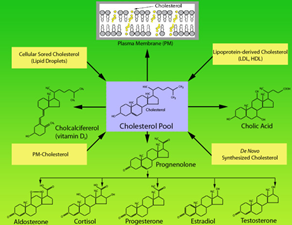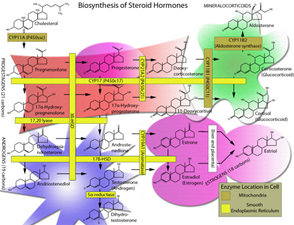I have some questions around cholesterol levels and sex hormones as I've seen several clients with high cholesterol and Lipo(a) markers) that are in perimenopause or menopause and/or recently after a pregnancy.
QUESTIONS
- What are some mechanisms that can help determine if High Cholesterol could be a result of insufficient conversion into sex hormones (not even sure if low sex hormones from a dutch test could be a good indicator)?
- What is required of the body in order to convert cholesterol into sex hormones?
ANSWER
Yes, it’s so important to recognize that sex hormones (progesterone, testosterone, estrogen) are produced from cholesterol and that cholesterol should no longer be “demonized” as if it were a dangerous toxin. Cholesterol is also essential to cell membrane structure and fluidity, synthesis of vitamin D, squalene, bile acids, cortisol, aldosterone, DHEA, and other adrenal androgens.
Huff, Trevor, et al. "Physiology, Cholesterol." StatPearls, StatPearls Publishing, 2 March 2021. [R]
The first step regarding the clients mentioned would be to look back at their cholesterol and lipoprotein(a) levels over time. Have they been elevated right along or did levels go up around menopause or pregnancy? Increases in serum cholesterol are normal during menopause and pregnancy.
Wang, N et al. Zhonghua xin xue guan bing za zhi vol. 44,9 (2016): 799-804. doi:10.3760/cma.j.issn.0253-3758.2016.09.013 [R]
Grimes, Sarah B, and Robert Wild. “Effect of Pregnancy on Lipid Metabolism and Lipoprotein Levels.” Endotext, edited by Kenneth R Feingold et. al., MDText.com, Inc., 20 February 2018. [R]
A complex relationship exists between cholesterol and estrogen. Though estrogen is produced from cholesterol, estrogen itself induces HMG-CoA reductase, the key enzyme in cholesterol synthesis. Estrogen also favorably increases cholesterol incorporation into HDL and reduces LDL cholesterol. This benefit may dissipate following menopause.
Mao, Zhuo, Jinghui Li, and Weizhen Zhang. "Hormonal regulation of cholesterol homeostasis." Cholesterol-Good, Bad and the Heart (2018). [R]
Mumford, Sunni L et al. “A longitudinal study of serum lipoproteins in relation to endogenous reproductive hormones during the menstrual cycle: findings from the BioCycle study.” The Journal of clinical endocrinology and metabolism vol. 95,9 (2010): E80-5. doi:10.1210/jc.2010-0109 [R]
Unfavorable changes appear to take place around menopause including an increase in total and LDL cholesterol, as well as a decrease in LDL particle size, which enhances atherogenicity.
Wang, Qin et al. “Metabolic characterization of menopause: cross-sectional and longitudinal evidence.” BMC medicine vol. 16,1 17. 6 Feb. 2018, doi:10.1186/s12916-018-1008-8 [R]
Re: What are some mechanisms that can help determine if High Cholesterol could be a result of insufficient conversion into sex hormones (not even sure if low sex hormones from a dutch test could be a good indicator)?
The exact causes of elevated cholesterol are not always discernible and a full assessment and genetic profile would provide the most useful information. Whether or not cholesterol increases as a direct result of low sex hormones is unclear, especially since serum cholesterol is only one of the sources used for the synthesis of steroid hormones. Cells are able to synthesize cholesterol locally in order to ensure a constant supply, so they are not fully dependent on serum levels.
Hu, Jie et al. “Cellular cholesterol delivery, intracellular processing and utilization for biosynthesis of steroid hormones.” Nutrition & metabolism vol. 7 47. 1 Jun. 2010, doi:10.1186/1743-7075-7-47 [R]
Besides menopause (a low-estrogen state), elevated cholesterol has been associated with testosterone (T) deficiency, although elevations may be related to the metabolic factors and metabolic syndrome also related to low T.
Kelly, Daniel M, and T Hugh Jones. “Testosterone: a metabolic hormone in health and disease.” The Journal of endocrinology vol. 217,3 R25-45. 29 Apr. 2013, doi:10.1530/JOE-12-0455 [R]
The DUTCH test (Dried Urine Testing for Comprehensive Hormones) is considered to be comparable to liquid urine testing for reproductive hormones in pre- and post- menopausal women, so it can be considered a valid tool for evaluation.
Newman, Mark et al. “Evaluating urinary estrogen and progesterone metabolites using dried filter paper samples and gas chromatography with tandem mass spectrometry (GC-MS/MS).” BMC chemistry vol. 13,1 20. 4 Feb. 2019, doi:10.1186/s13065-019-0539-1 [R]
Re: What is required of the body in order to convert cholesterol into sex hormones?
Cholesterol is converted to sex hormones via a process known as steroidogenesis. The rate-limiting step is the first step in the process: conversion of cholesterol to pregnenolone via action of the P450 enzyme CYP11A1, a step that is highly regulated. The next steps are determined by a variety of P450 enzymes, dehydrogenases, and cofactors which then facilitate conversion to specific hormones such as DHEA, testosterone, and estrogen. The graphics below illustrate the process.
Miller, Walter L, and Richard J Auchus. “The molecular biology, biochemistry, and physiology of human steroidogenesis and its disorders.” Endocrine reviews vol. 32,1 (2011): 81-151. doi:10.1210/er.2010-0013 [R]


Source: Hu, Jie et al. “Cellular cholesterol delivery, intracellular processing and utilization for biosynthesis of steroid hormones.” Nutrition & metabolism vol. 7 47. 1 Jun. 2010, doi:10.1186/1743-7075-7-47 [R] This is an Open Access article distributed under the terms of the Creative Commons Attribution License ([R])
